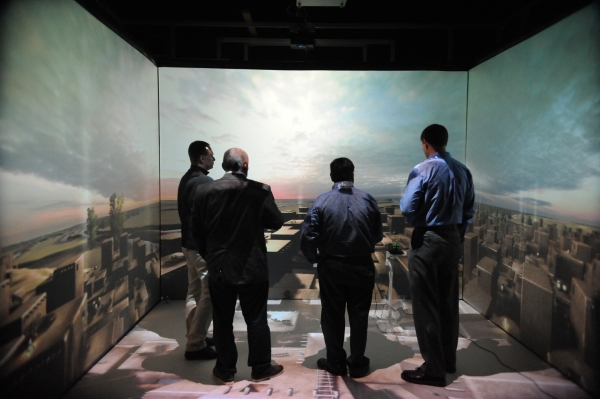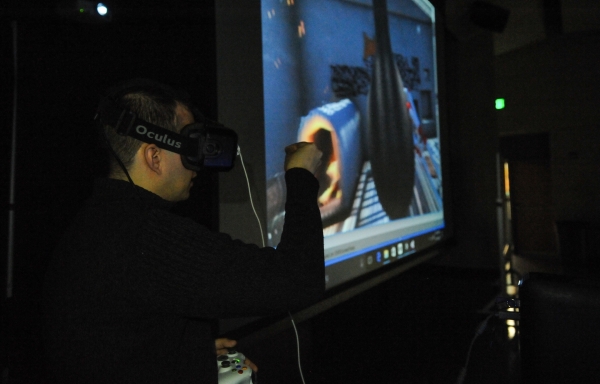VMASC Researchers Host Archaeologists from Around the World, Examining 3-D Visualization of Ancient Settlement
November 30, 2016
 The immersive environment created to look like Çatalhöyük did at its peak 9,000 years ago.
The immersive environment created to look like Çatalhöyük did at its peak 9,000 years ago.
 Researcher Bratislav Cvijetic explores Çatalhöyük through virtual reality technology.
Researcher Bratislav Cvijetic explores Çatalhöyük through virtual reality technology.
The ancient settlement of Çatalhöyük existed from approximately 7500 to 5700 B.C. in what is now Turkey.
Its civilization has been lost to history, but it has been a research passion of archaeologists from around the world for more than 20 years. At a recent research conference at Old Dominion University, these scholars received a chance to "visit" Çatalhöyük without leaving the United States.
At the conference, co-hosted by Old Dominion's Virginia Modeling, Analysis and Simulation Center (VMASC), experts who have unearthed artifacts and discovered information about Çatalhöyük journeyed back in time through a visualization created at the University, based on the archaeological findings. Also on display were 3-D visualizations created by other research groups.
The project represents ODU's commitment to take modeling and simulation research into other domains, bringing the discipline to fields such as health care and manufacturing.
Saikou Diallo, research associate professor and co-organizer of the conference, said the visualization of the ancient civilization was created to depict life in Çatalhöyük during its peak period 9,000 years ago.
"We want to transport you back into that time," Diallo said. "We've included the sounds and smells. We'd like you to sip on herbal tea that would have been drunk."
Diallo said the effect is meant to mimic the hands-on learning techniques frequently employed by museums that cater to large populations of children. "My frustration at how information like this is taught is part of this. We can do so much more now with the use of immersive simulations, virtual reality," Diallo said.
First excavated in 1958, the ruins of Çatalhöyük were dedicated as a UNESCO World Heritage Site in 2012.
VMASC and the Institute for the Bio-Cultural Study of Religion, a think tank dedicated to the non-partisan scientific study of religion, invited researchers from around the world to exchange ideas and show work in progress on 3-D, immersive visualizations of how life may have looked in Çatalhöyük, before any of the world's great civilizations arose.
Conference participants met in the Cave Automatic Virtual Environment (CAVE) in ODU's E.V. Williams Engineering and Computational Sciences Building. In addition to an immersive visit to Çatalhöyük, attendees took part in hands-on demonstrations using virtual reality tools, where they were able to "handle" artifacts that might have been present in the settlement during that time.
Diallo has utilized modeling and simulation in unorthodox ways, including modeling the spread of religions around the world. These studies connected him with the Institute for the Bio-Cultural Study of Religion, which is headquartered in Boston.
Diallo sees the potential in this type of visualization for archaeologists and scholars of religion alike. How important was religion in the formation of Çatalhöyük? "You could actually have them both exploring this environment, where they could analyze competing theories simultaneously and discuss their different interpretations," he said.
VMASC researchers Krysztof Rechowicz, Bratislav Cvijetic and Hector Garcia also have worked on the Çatalhöyük project.

